Manuscript accepted on : 15 February 2012
Published online on: --
Malihe Movassagbehestani
Physical Education, Sports College, Ankara Gazi Univeristy, Tehran, Iran.
ABSTRACT: The purpose of this study was to investigate the effect of a 12-week selective aerobic exercise trial in water on bone density in obese postmenopausal women.Twenty obese post-menopausal women as subject to participate in this study. Subjects randomly divided into an experimental and control group. The experimental group performed selective aerobic training in water for 3 month, first month: 3sessions/wk, second month: 4 sessions/wk and last month: 5 sessions/wk. Each session lasted 90 min with the exercise intensity 65-75% of HRmax in all of sessions. Control group did not participate in any physical activity program during study period. Bone density of lumbar spine and femur were measured in both groups in before and after exercise training period by densitometry method. Also, calcium and phosphorus was measured in same times. Data analyzed with paired and independent samples T-Test. The results of this study indicate that there was a significant increase in femoral bone density in experimental group compared with control group in end of study period (P<0.05). Also, the lumbar spine bone density was increased moderately, but not significantly, in experimental group. On the other hand, calcium and phosphorus levels were not different significantly between experimental group and control group in end of study period (P<0.05). The results of this study indicate that one period of selective aerobic exercise trial in water enhanced femoral and lumbar spine bone density in obese postmenopausal women.
KEYWORDS: Osteoporosis; Menopause women; Aerobic exercise; Thigh bone
Download this article as:| Copy the following to cite this article: Movassagbehestani M. Ffects of A 12-Week Aerobic Exercise on Back Spine and Thigh Bone Mineral Density in Heavy Women After Menopause. Biosci Biotech Res Asia 2012;9(1) |
| Copy the following to cite this URL: Movassagbehestani M. Ffects of A 12-Week Aerobic Exercise on Back Spine and Thigh Bone Mineral Density in Heavy Women After Menopause. Biosci Biotech Res Asia 2012;9(1). Available from: https://www.biotech-asia.org/?p=9493 |
Introduction
As life expectancy has increased, osteoporosis has been more frequently diagnosed in women and men worldwide [1,2].Osteoporosis is the most common bone disorder in the world [3].It is defined as “a skeletal disease, characterized by low bone mass and micro-architectural deterioration of bone tissue, with a consequent increase in bone fragility to fracture” [4]. Pursuant to the International Osteoporosis Foundation (IOF), 40% of women have fracture due to osteoporosis during their lifetime [5].The impact of osteoporosis and fragility fractures increases as the population ages. The lifetime risk of any osteoporotic fracture is high and can be as high as 40–50% in women and 13–22% for men [6]. Osteoporosis is still afrequently under-recognized disease and considered to be an inevitable consequence of ageing [7].As a disease of the elderly, the prevalence will increase as the population ages. Currently every third post-menopausal woman and every fifth man older than 50 years, suffer from osteoporosis [8].
Osteoporosis as a multi-factor disease of skeletal system, is the major cause of reductioninquality of life, fracture and death of old people especially women aftermenopause [9].The menopause is a time when many women seek advice about bone health and their risk of osteoporosis. In the majority of early postmenopausal women, fracture probability is low and intervention to prevent bone loss is not indicated [10].Menopause, whether it occurs naturally or surgically, is characterized by the loss of hormones produced by the ovaries. In natural menopause ovarian function decreases slowly over several years until menstruation ceases [11]. Osteoporosis is most common among women than men and increases as the levels of estrogen decrease. From the other side, preventing the reduction of bone mineral density or attempts to maintain it is the best way to deter its occurrence in elderly women after menopause. Different treatments to prevent the reduction of bone mineral densityincluding estrogen therapy, skeletal anti-reabsorption drugs and physical activities have been tried [12].But results of studies on medical methods to stoposteoporosis indicate that, in spite of their preventive efficiency, these methods in the long run may induce heart diseases, breast cancer and heart attack, while physical activities have positive effects on preventing the reduction of bone mineral density with no side effects. Thus, exercise therapy has been recently considered by a great number of researchers[9]. But from among different exercises, water exercises have been given less examination. Water is a medium that forces resistance appropriate to every individual’s bodily requirements and so enhances physical activities and competition between muscular groups to suppress resistanceandalso can be effective to increase mechanical strain on bones and bone formation [13].Unlike other exercises, water exercise can also increase competition between upper and lower organs in an appropriate domain of movement; thus in these activities the jointsendure less strain. From the other side, water exercises enhance old people’s capability to keep their balance and this way decreases the risk of falling and fragility fracture [13].
Considering the developing approaches of treatment to stop osteoporosis in old people, especially heavy women after menopause, and the importance of water exercises as an appropriate and less-risky approach, we tried to study the effect of a 12-week aerobic exercise on back bone and thigh bone mineral density in heavy women after menopause.
Materials and Methods
Candidates
the data were gathered from 20 heavy women after menopause from Urmia(50-55 years) with BMI≥30 that wanted to use swimming pool for the first time and,according to the health questionnaire and the physician, possessed the requirements to take part in the study.They had no experience in sport exercises in the past. They were divided randomly in two groups, the exercise group and the control group. The exercise group did aerobic exercises in water for 12 weeks while the control group had no physical activities during the study.
Exercise Protocol
In the present study all the exercises were practiced in a pool with 120 cm depth, in the way that candidates had their heads and necks above the water. The procedure included: warm up, stretching exercises, jumping exercises, aerobics, flexibility and then cooling down to return to the primarycondition. During the exercises, heart beat started from the estimated maximum 65 percent and increased to 75 percent at the end and the candidates did the exercises in the range of 110-130 beat per minute.The duration of each exercise session was 90 minutes. To control the intensity of exercises, heart beat was measured by a pulsometer3 times during the exercise: before and after aerobic exercises and after cooling respectively. To consider the principle of extra load during exercises, first the repetition of the movements were increased, then break time shortened and then weight was increased by water bottles and speed increased by music. During the exercises, variety was brought into account. The frequency of sessions in the first month was 3 sessions a week and for the second month was 4 that increased to 5 sessions in the third month.
Data-gathering method
In the first place candidates were asked not to do physical activities of any sort two days before the experiment. To measure research variables, blood-sampling was done between 8 to 10 in the morning, 12 hours hungry a day before the experiment.So from the vein of each candidate left hand in sitting and resting positions 10 mL blood was taken. Parathormonemeasurements were done in vitro after providing serum exploiting DiaSorinInc N-tact PTH IRMA kit by Immunoradiometric Assay method using the Minineph device made in US. 25 hydroxy vitamin D3serum values were analyzedbyImmunoassay method. Calcium and phosphor plasma values were measured by PX Daytona automated chemistry analyzer. At the end of exercise period and 48 hours after the last session, the control and the exercise groups were collected again in vitro and their blood and urine samples were taken. All the experiments were done in biochemistry laboratory of Urmia University. Bone mineral density values in back and thigh bones before and after the exercise period in both groups were measured in the density measurement and osteoporosis diagnosis center by a radiograph with the maximum raypower 3 M REM using DEXA device in the density measurement and Osteoporosis diagnosis center.
Statistical analysis
To determine the measured values of variables in groups we used descriptive statistics and to determine the differences in each group and between the two groups we used correlated and independent t test respectively. A significant level of alpha error (p<0.05) was also considered.
Results
Results of correlated t test to compare values before and after exercise period in groups indicate that performing exercise protocol significantly increased the average of thigh bone mineral density, level of parathormone, 25 hydroxy vitamin D3 and calcium serum in the exercise group in a way that the average of results after the test were greater than those before the test (p<0.05).However, there was no change in values of the control group before and after the test. (Figures 1, 2, 3, 4, 5)
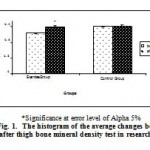 |
Figure 1: The histogram of the average changes before and after thigh bone mineral density test in research groups.
|
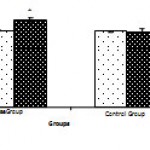 |
Figure 2: The histogram of the average changes before and after parathormone serum test in research groups.
|
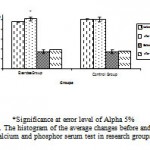 |
Figure 3: The histogram of the average changes before and after calcium and phosphor serum test in research groups.
|
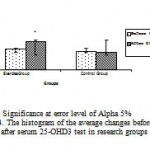 |
Figure 4: The histogram of the average changes before and after serum 25-OHD3 test in research groups.
|
Results of independent t test also indicate that there are significant differences in the average of thigh bone mineral density, level of parathormone and calcium serum between the groups (p<0.05).The average of density changes of these indexes in the exercise group after exercises was significantly greater than the control group (Fig. 5).
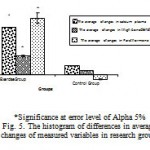 |
Figure 5: The histogram of differences in average changes of measured variables in research groups.
|
From the other side, results of correlated t test tocompare the values before and after exercise period indicate that performing exercise protocol had no significant effect on back spine bone mineral density in either groups(p<0.05) (Fig. 6).
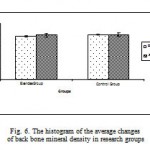 |
Figure 6: The histogram of the average changes of back bone mineral density in research groups.
|
Discussion
Results of the study show that performing a 12-week aerobic exercise period in water had significant effect on thigh bone mineral density and increased its density in the exercise groupthanthe control group. Although not much research is done to study the effects of exercises in water on bone mineral density, results of present study are in accordance with the findings of Tanya et al (2006)[13].These researchers, in their study of the effects of a 12-week aerobic exercises in shallow water on bone mineral density in menopause women,reported that these exercises keep and improve bone density in thigh bones.Results of present study are in accordance with researches that show the positive effect of weight-bearing [14] and resistance exercises [15]on land on thigh bone mineral density. For example, George and et al, reported that doing aerobic exercises continuously increases thigh bone mineral density [16].Rhodes and et al, also reported that doing aerobic exercises for a year increases thigh bone mineral density [17]. From the other side, results of present study are not in accordance with findings of Bravo and et al [28].
These researchers studied the effects of a 12-week weight-bearing exercise in water on thigh and back spine bone mineral density in women after menopause and reported that back spine bone density decreased but thigh bone density didn’t change. This difference seems to be due toduration and intensity of exercises in the two studies [18]. Bravo did his study with threesessions a week and no control on intensity of exercises, while we did our study in an increasing period starting from three sessions a week in first month to 5 sessions in third month. Intensity in the whole period was 65 to 75 percent of heart beat. It should be noted that the number ofsessions in a week, time-period and intensity of exercises are key factors that affect bones’ response to mechanical and dynamic strains [15] [19].For example, Snow and et al, reported that resistance exercises with low frequency and more weight improves thigh bone mineral density better than exercises with high frequency and less weight [15].Krall and et al, using an evaluative questionnaire for different levels of physical activities in women after menopause reported thatbone mineral density in women who walk more than 7.5 miles a week is significantly more than women that walk less than a mile in week [20].Duration and intensity of exercises should be such that induce bone modeling factors [21]. The least intensity and duration that can cause this are called Minimum effective exercise intensity and Minimum effective exercise duration respectively [22]. Frost in his theory suggests that bone structure is maintained through a feedback system in a way that increase in mechanical and dynamic strain induces bones and causes modeling of bones. This theory is known as MechanostateTheory.According to this theory, mechanical strain should be as much to cause bone formation or modeling to precede bone reabsorption process. This mechanical strain is called minimum effective strain threshold [23].
So in Bravo’s study, intensity and load of exercises were probably not in minimum effective strain threshold to improve thigh bone mineral density. From the other side, the present study showed that aerobic exercises in water for 12 weeks didn’t have significant effects on back spine bone mineral density and just slightly increased bone mineral density in back spine in the exercise group than the control group (p>0.05). Few researches have been done to study effects of exercise in water on bone mineral density especially in back spine.Harush and et al, and Ay and et al, reported that doing aerobic exercises in water maintains and even improves bone mineral density in women after menopause [24][25]. Yamazaki and et al. also studied the effect of walking on bone metabolism in menopause women and reported that doing these exercises for 12 months increases back spine bone mineral density insignificantly [26].Sinaki and et al, also reported the insignificant difference in back spine bone mineral density after doing resistance exercises for three years [27].From the other side, results of the present study were not in accordance with findings of Tskahara and et al [28]. These researchers studied the effect of 32 months aerobic exercise in water and reported a significant increase in back spine bone mineral density in the exercise group than the control group.This difference may probably be because of differences in duration and kind of activities [9]. Results of previous studies show site-specific effects of exercise on bones of different parts of the body[29]. Exercise affects bone mineral density of different parts of the body when it increases mechanical load or dynamic strain of that site of the body. It should be noted, however, that different bones reflect different bone modeling responses to mechanical and dynamic strains [27]. In a way that the level of bone formation in cortical bones like thigh bones is greater than cancellous bones like back spine bones. Results of different researches show that responses of cortical bones like thigh bone to mechanical or dynamic strains are greater than cancellous bones like back spinebones[30]. So these bones need more time to have positive responses to mechanical or dynamic strains of exercises [31].Rockwell and et al, reported that resistance exercises for 9 months decrease bone mineral density in back spine bones [32].whileFrindlander and et al. showed that doing resistance exercises for 2 years with the same protocol has significant effects on back spine bone mineral density [31].
Results of present study indicate that doing aerobic exercises in water for 12 months had no significant effect on plasma phosphor level in the exercise group and there was no significant difference between the exercise group and the control group for this index (p>0.05). Alice and et al. also reported no significant change in phosphor level after doing aerobic exercises in women after menopause [33].
However, calcium and 25 hydroxy vitamin D3plasma levelsat the end of exercise period in present study increased in the exercise group compared with the control group. There was also a significant difference in calcium level between the exercise group and the control group (p<0.05).Researchers believe that these changes are related to hormone factors that regulate calcium levels [33] [34].For example, parathyroid hormone (Parathormone) is an important factor in bone metabolism [35].One of the most important roles of this hormone is maintaining compatibility of calcium ion / nonorganic Phosphate through PTH / PTH recipient related to protein in kidney, bone and intestine [36]. Parathormoneincreases calcium plasma level through provoking reabsorption of calcium in kidneys and intestine and increases reabsorption of calcium in kidneys by increasing formation of 25 hydroxyvitamine D3.[16][34]The process of modeling and temporal increase in bone transformation is reported after a period of enduring and aerobic exercises. According to this process, doing systematized exercises increases 25 hydroxy vitamin D3 calcium plasma levels and,in the long run, increases bone mineral density and bone formation in competitive bones [16].
These changes were also observed in present study; according to our results, doing aerobic exercises in water significantly increases parathormone, calcium and 25 hydroxy vitamin D3 plasma levels in the exercise group in comparison with the control group (p<0.05).It seems that doing aerobic exercises for 12 weeks in present study changes calcium homeostasis and parathormonesecretion in a way that increasesbone mineral density and bone formation [31].
Conclusion
Results of the study indicate that aerobic exercises in water as one of the most suitable and less-risky exercises can be performed to stop Osteoporosis or maintain / adjust bone mineral density in old people especially women after menopause.
Reference
- Braidan I, Baris C, Wood L, Selby P, Adams J, Freemont A, et al. Preliminary evidence for impaired estrogen receptor a protein expression in osteoblasts and osteocytes from men with idiopathic osteoporosis. Bone 2000;26: 423—7.
- Notomi T, Okimoto N, Okazaki Y, Nakamura T, Suzuki M. Tower climbing exercise started 3months after ovariectomy recovers bone strength of the femur and lumbar vertebrae in aged osteopenic rats. J Bone Miner Res 2003;18:140—9.
- Facts and statistics about osteoporosis and its impact. International Osteoporosis Foundation. http://osteofound.org/press_centre/fact_sheet.html. Accessed June 2007.
- Prevention and management of osteoporosis. World Health Organ Tech Rep Ser 2003;921:1–164.
- International Osteoporosis Foundation (on line). Available from: http://www.osteofound.org/index.php [accessed 19.09.05].
- Kanis, J.A., Johnell, O., Oden, A., Borgstrom, F., Zethraeus, N., De Laet, C., Jonsson, B., 2004.The risk and burden of vertebral fractures in Sweden.Osteoporos. Int. 15, 20–26.
- Compston J. Osteoporosis: social and economic impact. RadiolClin North Am 2010;48:477–82.
- OlszynskiWP, Shawn DK, Adachi JD, et al. Osteoporosis in men: epidemiology, diagnosis, prevention, and treatment. ClinTher 2004;26(1):15–28.
- Maimoum L, Manetta J, Couret I, Dupuy AM, MarianoـGoular D, Micallef JP, et al. The intensity level of physical exercise and the bone metabolism response. Int. J. Med(2006); 332: 305ـ311.
- Juliet Compston, 2005, How to manage osteoporosis after the menopause, Best Practice & Research Clinical Rheumatology, Vol. 19, No. 6, pp. 1007–1019
- Langren BM, Collins A, Csemiczky G, Burger HG, Baksheev L, Robertson DM. Menopause transition: annual changes in serum hormonal patterns over the menstrual cycle in women during a nine-year period prior to menopause. J ClinEndocrinolMetab 2004;89(6):2763–9.
- Nazarian BA, Khayambashi KH, Rahnama N, Salamat M. The Comparison of Bone Mineral Density in Lumbar Spines and Femoral Bone Between Professional Soccer Players and Non-Athlete Subjects. Olympic quarterly (2009); Thesixteenth.No 2.42
- Tanya RL, Christine M. Bone density and physical function in postmenopausal women after a 12ـMonth water exercise intervention. Orgon State University Bone Research Laboratory, Corvallis (2006); OR 97331, (541) 737ـ9524.
- Chie MY, Wu YT, Hsu AT, Yang RS, Lai GS. Efficacy of a 24ـWeek Aerobic Exercise Program for Osteopenic Postmenopausal Women.Calcif Tissue Int (2000); 67:443–448.
- Snow CM, Shaw JM, Winters KM, Witzke KA. Longـterm Exercise Using Weighted Vests Prevents Hip Bone Loss in Postmenopausal Women. J Gerontol A BiolSci Med Sci(2000); 55(9):M489ـ491.
- George A, Kelley F. Aerobic Exercise and Bone Density at the Hip in Postmenopausal Women: A MetaـAnalysis (2002);pp:60115ـ2854.
- Rhodes EC, Martin AD, Taunton JE, Donnelly M, Warren J, Elliot J .Effects of one year of resistance training on the relation between muscular strength and bone density in elderly women. Br J Sports Med 2000; 34:18ـ22.
- Bravo G, Gauthier P, Roy PM, Payette H, Gaulin P. A waight –bearing, waterـbased exercise program for osteopenic women: its impact on bone, functional fitness, and wellـbeing. Arch Phys Med Rehabil(1997).
- Todd JA, Robinson RJ. Osteoporosis and exercise. Postgrad Med J(2003);79:320–323.
- Krall EA, DawsonـHughes B. Walking is related to bone density and rates of bone loss. Am J Med(1994); 96:20–6.
- Katsuta S, Shimegi S. Relationship between muscle and bone tissue. Bone(1993); 17:61–69 (in Japanese).
- Iwamoto J, Takeda T, Ichimura S. Effects of Exercise on Bone Mineral Density in Mature OsteopenicRats(1998); 13(8):1308ـ1317.
- Frost HM. The role of changes in mechanical usage set points in the pathogenesis of osteoporosis. J Bone Miner Res (1992); 7:253–261.
- Ay A, Yurtkuran M. Influnce of aquatic and weight –bearing exercises on quantitative ultrasound variables in postmenopause women. Am J Phys Med Rehabil (2005);84 (1): 52ـ61
- Harush, D, Rotstein A. The Effect of a Water Exercise Program on Bone Density among Postmenopausal Women (2004).
- Yamazaki S, Ichimura S, Iwamoto J, Takeda T, Toyama Y. Effect of walking exercise on bone metabolism in postmenopausal women with osteopenia/osteoporosis. J Bone Miner Metab (2004); 22:500–508.
- Sinaki M, Wahner HW, Bergstralh EJ,. Threeـyear controlled randomized trial of the effect of doseـspecified loading and strengthening exercises on bone mineral density of spine and femur in nonathletic, physically active women. Bone (1996); 19:233–44.
- Tskahara N, Toda, A, Goto, J, Ezawa, I. Crossـsectional and longitudinal studies on the effect of water exercise in controlling bone loss in Japanese postmenopausal women. Journal of Nutritional Science and Vitaminology, Japan WomensUniversity(1994).
- Brard A,. Bravo G, GauthieP .Metaـanalysis of the Effectiveness of Physical Activity for the Prevention of Bone Loss in Postmenopausal Women.OsteoporosInt(1997); 7:331ـ337.
- Lohman, T, Going S. Pamente R, Hall L, Boyden T, Houtkooper L, et al. Effects of resistance training on regional and total bone mineral density in premenopausal women: A randomized prospective study. J Bone Miner Res(1995); 10(7): p. 1015ـ1024.
- Friedlander AL, Genant HK, Sadowsky A, By NN, Gluer CC. A twoـyear program of aerobics and weight training enhances bone mineral density of young women. J Bone Miner Res (1995;) 10(4): p. 574ـ585.
- Rockwell JC, Sorensen AM, Baker S, Leahey D, Stock JL, Michaels J, et al. Weight training decreases vertebral bone density in premenopausal women: A prospective study. J. Clin. Endocr.Metab(1990); 71: 988ـ993.
- Alice S, Ryan R, Barbara J, Nicklas, Karen E. Aerobicexercise maintains regional bone mineral density during weight loss in postmenopausal women.JApplPhysiol(1998); 84: 1305ـ1310.
- Linda L, Lin S, Hsieh S. Effects of strength and endurance exercise on calciumـregulating hormones between different levels of physical activity. J. Mechanics Med. Bio(2005); 5:267ـ275.
- Eriksen EF, Charles P . New markers of bone metabolism: Clinical use in metabolic disease. Eur. J. Clin. Endocrinol(1995); 132:251ـ263.
- Barrett, MG, Belinsky GS, Tashjian AH. A new action of paratiroidhormone.Receptorـmediated stimulation of extracellular acidification in human osteoblastـlike SaOSـ2cells. J. Biol. Chem(1997); 272:26346ـ26353.

This work is licensed under a Creative Commons Attribution 4.0 International License.





